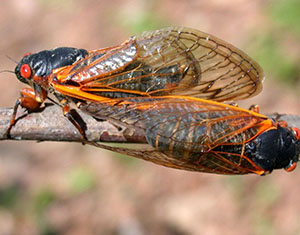 Purdue University - Extension - Forestry and Natural Resources
Purdue University - Extension - Forestry and Natural Resources
Got Nature? Blog
The sound of cicadas is one of the more distinguishable nature sounds of the Midwestern summer. Whether you love it or hate it, the call of the cicadas will be returning this summer in a different and likely louder way than in the past couple years in Indiana.

Photo credit: John Obermeyer
Cicadas are interesting insects, living the vast majority of their lives underground as larvae for several years before emerging to the surface to shed their shells and become adults for around a month and reproduce before dying. In general, there are two types of cicadas: annual and periodical.
Annual cicadas are about two inches long and are greenish in color. They are found in vast numbers in the late summer and early autumn. Unlike their name suggests, they live as larvae for two to three years before emerging, but due to overlapping generations, they can be heard every year. They produce their loud, buzzing and ticking calls from their abdomen to attract mates.
In contrast, the periodical cicadas emerge much less frequently. There are two groups of periodical cicadas, one that emerges from its larval state after 13 years and another that emerges after 17. There are 23 observed broods of these that have been well documented by entomologists for decades. These insects are different visually and audibly from their annual relatives. The periodical cicadas have red eyes and orange and black bodies, as opposed to the annual cicada’s green appearance. As well as a buzzing sound, they can also produce a unique, high-pitched tone sounding like “weeee-ooh” or “pharoah.”
Brood XXIII of the 13-year periodic cicadas will emerge this June, and it is expected to be a big one. While loud, these insects are fairly harmless. They don’t pose a risk to humans as they don’t bite or sting. However, the egg laying process can be harmful to young trees with branches less than 3/4 of an inch thick. These trees can be covered with screens to allow sunlight to still reach the trees while keeping the cicadas out. Pesticides are typically avoided since the adult cicadas do not feed on the trees and will not ingest the chemicals.
If you see the periodical cicada emerge in your area, you can email LCaplan@purdue.edu or call 812-435-5287 to help continue to monitor and document these insects.
Resources
Periodical Cicada Reports From Southern Indiana, Purdue Extension
Periodical Cicada In Indiana, Indiana Department of Natural Resources
Periodical Cicada In Indiana, The Education Store
Larry Caplan, Horticulture Educator
Purdue Extension

Recent Posts
- Professor of Wood Processing and Industrial Engineering Rado Gazo Featured in ANR Newsletter
Posted: November 12, 2024 in Forestry, Wood Products/Manufacturing, Woodlands - Learn to Process Your Own Deer – Wild Bulletin
Posted: November 11, 2024 in Aquatic/Aquaculture Resources, Forestry, How To, Wildlife - Leaving Leaves Benefits Wildlife – Wild Bulletin
Posted: in Forestry, Forests and Street Trees, Gardening, Urban Forestry, Wildlife - Experience Indiana’s Sandhill Crane Fall Migration
Posted: November 8, 2024 in Forestry, Wildlife - Purdue Extension’s Showcase, Impacting Indiana
Posted: in Community Development, Forestry, Forests and Street Trees, Gardening, Land Use, Natural Resource Planning, Timber Marketing, Urban Forestry, Wildlife, Wood Products/Manufacturing, Woodlands - Deer Season is Here, MyDNR and Wild Bulletin
Posted: in Forestry, Wildlife, Woodlands - ID That Tree: Learn to Identify Hoptree/Wafer Ash
Posted: October 30, 2024 in Forestry, Forests and Street Trees, How To, Urban Forestry, Wildlife - Publication – Handbook on Processing Fish for Small-Scale Fish Farmers
Posted: October 17, 2024 in Aquaculture/Fish, Aquatic/Aquaculture Resources, How To, Publication, Wildlife - When Roundup Isn’t Roundup – Purdue Landscape Report
Posted: in Forestry, Gardening, Plants, Urban Forestry - American Citizen Planner – Indiana Program Celebrating 4 Years of Impact
Posted: October 16, 2024 in Community Development, Land Use
Archives
Categories
- Alert
- Aquaculture/Fish
- Aquatic/Aquaculture Resources
- Ask the Expert
- Christmas Trees
- Community Development
- Disease
- Drought
- Forestry
- Forests and Street Trees
- Gardening
- Got Nature for Kids
- Great Lakes
- How To
- Invasive Animal Species
- Invasive Insects
- Invasive Plant Species
- Land Use
- Natural Resource Planning
- Nature of Teaching
- Plants
- Podcasts
- Ponds
- Publication
- Safety
- Spiders
- Timber Marketing
- Uncategorized
- Urban Forestry
- Webinar
- Wildlife
- Wood Products/Manufacturing
- Woodland Management Moment
- Woodlands